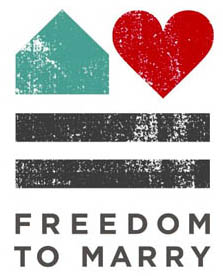
Freedom to Marry, a national nonprofit organization working for our right to legally marry, has published a thorough timeline and history of same-sex marriage in the United States, starting with Oct. 10, 1972, when the U.S. Supreme Court dismissed Baker v. Nelson, one of three cases brought by same-sex couples, challenging the denial of legally recognized marriage. Read the timeline below and click over to Freedom to Marry for an interactive graph.
October 10, 1972: The U.S. Supreme Court dismisses Baker v. Nelson, one of three cases brought by same-sex couples. challenging the denial of marriage. A Minnesota couple, Richard Baker and James Michael McConnell, were denied a marriage license by the Hennepin County District Court’s clerk on May 18, 1970. Their initial trial court dismisses their claim and affirms that the clerk could refuse gay couples a marriage license. The couple loses again in the Minnesota Supreme Court, and the U.S. Supreme Court summarily affirmed in a ruling now long since superseded by progress, legal developments, and greater understanding of gay people and why marriage matters.
January 1, 1973: Maryland becomes the first state to pass a statute banning marriage between same-sex couples when it includes in its Family Law Code a line reading, “Only a marriage between a man and a woman is valid in this State.” In waves of political attacks to block the freedom to marry in the 1990s and 2000s, numerous other states in the country pass similarly restrictive statutes.
November 9, 1973: The Kentucky Court of Appeals rules in Jones v. Hallahan that same-sex couples may not marry. The case comes after Marjorie Jones and Tracy Knight applied for and were denied a marriage license in Jefferson County, KY.
May 20, 1974: The Court of Appeals of Washington denies the case of Seattle residents John Singer and Paul Barwick, who challenged the denial of the freedom to marry to same-sex couples.
May 5, 1993: The Hawaii Supreme Court rules in Baehr v. Lewin that denying marriage to same-sex couples violates the Equal Protection Clause of the Hawaii Constitution. The case had been filed two years earlier on behalf of three same-sex couples – Ninia Baehr, Genora Dancel, Tammy Rodrigues, Antoinette Pregil, Pat Lagon, and Joseph Melilio. The 1993 ruling means that if the state cannot show sufficient justification for its denial of the freedom to marry, the ban would be overturned.
September 21, 1996: President Bill Clinton signs the so-called Defense of Marriage Act (DOMA) into law. DOMA mandates unequal treatment of legally married same-sex couples, selectively depriving them of the 1,138+ protections and responsibilities that marriage triggers at the federal level.
December 3, 1996: Following the world’s first-ever trial on the freedom to marry, led by co-counsel Dan Foley and Evan Wolfson, Judge Kevin Chang rules that the state did not have a legitimate reason for depriving same-sex couples of the freedom to marry.
November 3, 1998: Anti-gay forces succeed in amending the Hawaii Constitution so as to prevent the courts from ending the exclusion of same-sex couples; under the Amendment, only the legislature can now cure that discrimination, notwithstanding the Equal Protection Clause. On the same day, anti-gay forces in Alaska pass Ballot Measure 2, which amends the state constitution to restrict marriage to different-sex couples.
September 22, 1999: California becomes the first state to create a domestic partnership statute, allowing same-sex couples to receive some, but not all, of the protections afforded by marriage. The statute has been expanded over time to include more of the protections afforded to different-sex couples, although it is no substitute for marriage itself.
December 9, 1999: The Hawaii Supreme Court, bound by the new restrictive constitutional amendment, dismisses the couples’ challenge and leaves standing the denial of marriage.
December 20, 1999: The Vermont Supreme Court rules in Baker v. State of Vermont that same-sex couples must be treated equally to different-sex married couples. The Vermont legislature responds by establishing civil union, a separate legal status that affords couples some, but not all, of the protections that come with marriage – falling short of the constitutional command of equality, but far more than gay couples have had before. The law goes into effect on July 1, 2000.
November 7, 2000: Anti-gay forces in Nebraska push through the discriminatory Initiative Measure 416 at the ballot, constitutionally prohibiting the state from respecting any form of family status or recognition for same-sex couples. In the years that follow, similar amendments are passed in 27 additional states, writing marriage discrimination into a total of 29 state constitutions and disadvantaging millions of same-sex couples across the country.
January 2003: Evan Wolfson founds Freedom to Marry, the campaign to win marriage nationwide.
November 18, 2003: The Massachusetts Supreme Court rules in Goodridge v. Department of Public Health that the state constitution mandates the freedom to marry for same-sex couples. Three months later, the Court reaffirms its decision, stating that only marriage – not separate and lesser mechanisms, such as civil union – sufficiently protects same-sex couples and their families.
May 17, 2004: Massachusetts becomes the first state in the United States to allow same-sex couples to share in the freedom to marry. Marriage opponents attempt to amend the constitution to strip away the freedom to marry, but the amendment is defeated on June 14, 2007, when over 75 percent of the state legislature votes to stand up for all families.
November 2, 2004: Anti-gay forces in eleven states, marshaled by Karl Rove, push through constitutional amendments to deny same-sex couples the freedom to marry. In Mississippi, Montana, and Oregon the amendments restrict marriage to different-sex couples. In the other states – Arkansas, Georgia, Kentucky, Michigan, North Dakota, Oklahoma, Ohio, and Utah – the amendments deny all forms of family recognition or status, including civil union and domestic partnership. A similar amendment banning marriage was passed in Missouri in August 2004.
January 19, 2005: The Louisiana Supreme Court reinstates a hurtful anti-family ban on marriage between same-sex couples, bringing the number of states with constitutional amendments against marriage to 17. The Supreme Court decision overturns an October 2004 ruling from District Judge William Morvant, who declared that constitutionally excluding same-sex couples from marriage is unconstitutional.
April 20, 2005: Connecticut Governor Jodi Rell signs a civil union bill into law, affording same-sex couples some – but not all – of the projections that marriage provides. The law goes into effect on October 1, 2005.
September 6, 2005: The California legislature becomes the first state legislature to pass a freedom to marry bill. The landmark bill is vetoed soon after passage by Governor Arnold Schwarzenegger. Two years later, the legislature again passes a marriage bill, and again, it is vetoed by Gov. Schwarzenegger.
November 8, 2005: The discriminatory constitutional amendment Proposition 2 is passed in Texas, constitutionally excluding same-sex couples from marriage. In April of that year, same-sex couples in Kansas are denied any form of family recognition by a similar anti-gay constitutional amendment.
October 25, 2006: The New Jersey Supreme Court issues a unanimous ruling in Lewis v. Harris that same-sex couples are entitled to all state-level spousal rights and responsibilities. The court defers to the legislature on the question of how to extend these rights and responsibilities, suggesting the state either permit couples to marry or create a separate legal status for same-sex couples, such as civil union. In December, the legislature fails to provide the full freedom to marry, settling for the creation of the separate and lesser mechanism of civil union.
November 7, 2006: Anti-gay activists continue their anti-marriage, anti-family agenda by passing constitutional amendments denying same-sex couples the freedom to marry in seven more states – Colorado, Idaho, South Carolina, South Dakota, Tennessee, Virginia, and Wisconsin. Arizona becomes the first state to reject an anti-gay marriage amendment at the ballot.
April 21, 2007: Washington state Governor Christine Gregoire signs a domestic partnership bill into law. In the weeks that follow, Oregon Governor Ted Kulongski and New Hampshire Governor John Lynch also sign a domestic partnership law and a civil union law, respectively. The laws take effect in WA, OR, and NH on July 22, January 1, and February 1, respectively.
May 15, 2008: The California Supreme Court determines in In Re: Marriage Cases that a state statute excluding same-sex couples from marriage is unconstitutional. Almost immediately, an initiative to overturn the court ruling (Proposition 8) qualifies for the November 2008 ballot. Same-sex couples begin marrying on June 16.
May 22, 2008: Maryland Governor Martin O’Malley signs into law a domestic partnership bill allowing same-sex couples in Maryland some – but not all – of the benefits that marriage affords. The law takes effect on July 1.
October 10, 2008: The Connecticut Supreme Court rules in Kerrigan v. Commissioner of Public Health, a case brought by Gay & Lesbian Advocates & Defenders, that same-sex couples are entitled to the freedom to marry. The law retroactively takes effect on October 1, allowing all couples the freedom to marry and converting existing civil unions between same-sex couples in the state into marriages.
November 4, 2008: Anti-gay forces push through Proposition 8, an anti-gay constitutional amendment that strips away same-sex couples’ freedom to marry and restricts marriage to different-sex couples. Similar amendments are passed in Florida and Arizona.
April 3, 2009: The Iowa Supreme Court hands down a unanimous decision in favor of the freedom to marry in Varnum v. Brien. The ruling goes into effect on April 27, and same-sex couples begin marrying.
April 7, 2009: Vermont pushes past civil union and embraces the freedom to marry when the state legislature overwhelmingly votes to override a veto from Governor Jim Douglas. Same-sex couples begin applying for marriage licenses on September 1.
May 6, 2009: Maine Governor John Baldacci signs a freedom to marry bill into law previously approved by the state Senate and House of Representatives. Almost immediately, anti-gay activists work to push a ballot measure that would overturn the freedom to marry.
May 26, 2009: The California Supreme Court rules that, notwithstanding Prop 8, marriages between same-sex couples that occurred in the four months between June and November remain valid.
May 31, 2009: Nevada approves a broad domestic partnership bill after the state legislature overrides a veto from the state’s governor. Later that summer, Wisconsin also approves a less expansive domestic partnership bill.
June 3, 2009: New Hampshire Governor John Lynch signs into law a freedom to marry bill approved by the state Senate and House of Representatives. The law takes effect on January 1, 2010 and loving and committed same-sex couples begin marrying in the state.
November 3, 2009: Anti-gay forces in Maine push through an anti-gay ballot measure to overturn the freedom to marry in the state and restrict marriage to different-sex couples.
December 18, 2009: District of Columbia Mayor Adrian Fenty signs a freedom to marry bill into law after it passes by a large majority of City Council members. The law takes effect on March 3, 2010.
July 8, 2010: U.S. District Court Judge Joseph Tauro rules in Gill v. Office of Personnel Management and Commonwealth of Massachusetts v. United States Department of Health and Human Services that DOMA’s Section 3, which restricts marriage to different-sex couples, is unconstitutional.
August 2010: CNN releases the first poll to show a national majority supporting the freedom to marry. The poll asked, “Do you think gays and lesbians should have a constitutional right to get married and have their marriage recognized by law as valid?,” and 52 percent of the respondents said yes, with only 46 percent saying no. In September, a similar poll by the Associated Press finds 52 percent of respondents agreeing that government should respect marriages between same-sex couples.
August 4, 2010: The U.S. District Court of Northern California declares that Proposition 8 violates the U.S. Constitution’s due process and equal protection clauses, finding it unconstitutional to exclude same-sex couples from marriage. The case is appealed to the U.S. Ninth Circuit Court of Appeals.
January 31, 2011: Illinois Governor Pat Quinn signs a civil union bill into law after it is approved by the state Senate and House of Representatives. Later in 2011, civil union laws are also approved in Hawaii, Delaware, and Rhode Island.
February 23, 2011: President Barack Obama and Attorney General Eric Holder declare that because it is indefensible under the constitutional command of equal protection, the Administration will no longer defend the so-called Defense of Marriage Act. In a number of challenges to DOMA, the Obama Administration files briefs detailing and repudiating the history of government discrimination brought on by the unconstitutional DOMA.
March 16, 2011: The Respect for Marriage Act, the bill that would overturn the so-called Defense of Marriage Act, is introduced. As of September 2012, the bill is supported by 156 cosponsors in the House and 33 in the Senate.
June 13, 2011: The U.S. Bankruptcy Court for the Central District of California in Los Angeles releases an opinion in In Re Balas and Morales finding Section 3 of the so-called Defense of Marriage Act unconstitutional. In a rare statement of support, the opinion was signed by 20 of the district’s bankruptcy judges. Following the opinion, the Department of Justice shifted its policy and no longer intervenes to block married same-sex couples from filing joint petitions for bankruptcy.
June 24, 2011: New York Governor Andrew Cuomo signs a freedom to marry bill into law, more than doubling the number of Americans living in a state with the freedom to marry. This marks the first time that a Republican-led legislative chamber seals the deal on marriage, with Republican senators providing the margin of victory.
January 26, 2012: The Maine Freedom to Marry Coalition delivers more than 105,000 signatures to the Secretary of State to place a citizen’s initiative on the November 2012 ballot. The measure would allow same-sex couples to receive a marriage license while also protecting religious freedom. Maine is the first state to proactively seek to win the freedom to marry at the ballot.
February 2, 2012: Freedom to Marry and the Human Rights Campaign team up to launch the Respect for Marriage Coalition, a group of over 50 civil rights, labor, progressive, faith, student, women’s, and LGBT organizations dedicated to repealing the so-called Defense of Marriage Act.
February 7, 2012: The U.S. Ninth Circuit Court of Appeals upholds the August 4 ruling that found that Proposition 8 in California violates the U.S. Constitution. Anti-gay marriage advocates petition for an en banc hearing, requesting that 11 judges from the Court hear the case.
February 13, 2012: Washington Governor Christine Gregoire signs the freedom to marry into law after the state Senate and House approve it. Almost immediately after its passage, anti-gay activists begin collecting signatures to place a measure on the November ballot that would overturn the new law. The law was set to take effect on June 7, but anti-gay activists managed to collect enough signatures to put a stay on the law until November.
February 16, 2012: The New Jersey legislature approves the freedom to marry, but soon after, New Jersey Governor Chris Christie vetoes the bill. Freedom to Marry and local advocates are now working to build support in the legislature in order to override the veto, just as in Vermont in 2009.
February 22, 2012: U.S. District Court Judge Jeffrey White rules in Golinski v. Office of Personnel Management, declaring that DOMA’s Section 3, which restricts marriage to different-sex couples, is unconstitutional. The cases have since been submitted for consideration by the U.S. Supreme Court.
March 1, 2012: Maryland Governor Martin O’Malley signs the freedom to marry into law after it passes out of the state Senate and House. Almost immediately after its passage, anti-gay activists begin collecting signatures to place a measure on the November ballot that would overturn the freedom to marry. If the referendum is blocked, the law will take effect on January 1, 2013.
May 8, 2012: Anti-gay forces in North Carolina manage to pass a constitutional amendment that excludes same-sex couples from all forms of family status.
May 9, 2012: President Barack Obama becomes the first sitting president in the United States to publicly announce support for the freedom to marry.
May 19, 2012: The National Association for the Advancement of Colored People (NAACP) joins the growing ranks of organizations who support the freedom to marry when the board approves a resolution supporting marriage for same-sex couples. In the weeks that follow, the National Center for La Raza (NCLR) and the League of United Latin American Citizens (LULAC), the nation’s largest and oldest Latino civil rights organizations, respectively, pass similar resolutions supporting all families.
May 24, 2012: U.S. District Judge Claudia Wilken finds the Defense of Marriage Act unconstitutional in Dragovich v. U.S. Department of Treasury.
May 31, 2012: The U.S. First Circuit Court of Appeals finds the Defense of Marriage Act unconstitutional in two cases: Gill v. Office of Personnel Management andMassachusetts v. United States Department of Health and Human Services. Two of the three judges who joined the ruling, including its author, Judge Michael Boudin, were appointed by Republican presidents.
June 5, 2012: The full U.S. Court of Appeals for the Ninth Circuit denies anti-gay activists’ petition for an en banc rehearing of the Proposition 8 case. The denial of the petition means that the Court’s decision from February 2012, which found Prop. 8 to be unconstitutional, will stand. The case has since been submitted for consideration by the U.S. Supreme Court.
June 6, 2012: In New York, U.S. District Court Judge Barbara Jones finds the Defense of Marriage Act unconstitutional in Windsor v. United States. Judge Jones is the fifth federal judge to rule that DOMA’s Section 3 violates the U.S. Constitution. The case has since been submitted for consideration by the U.S. Supreme Court.
July 31, 2012: In Connecticut, U.S. District Court Judge Vanessa Bryant finds the Defense of Marriage Act unconstitutional in Pedersen v. Office of Personnel Management. The case has since been submitted for consideration by the U.S. Supreme Court.
September 4, 2012: The Democratic Party becomes the first major U.S. political party in history to officially endorse the freedom to marry in their national party platform when the platform is ratified at the Democratic National Convention. The plank supporting the freedom to marry was the focus of Freedom to Marry’s Democrats: Say I Do campaign calling for the plank.
November 6, 2012: Marriage-related ballot measures are up for a vote in 4 states this November. In Washington and Maryland, ballot-measures ask voters to uphold freedom to marry legislation. Minnesota faces a proposed amendment that would cement the exclusion of same-sex couples from marriage into the state constitution. Maine is working proactively on a campaign to win the freedom to marry at the ballot.





























